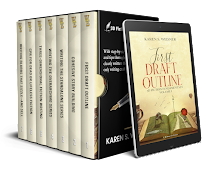Taking the Bucket Out of the Bucket List, Part 1
by Karen S. Wiesner
In this updated, two
part reprisal of earlier posts on the Alien Romances blog, I discuss the wisdom
and benefits of, and strategies for, drawing up a personal bucket list as early
as possible--long before the curtain of a life is drawn. Only slightly belated as you draw up your New Year's resolutions, I encourage everyone, not just those interested in writing (or aliens!), to read this.
About 10 years ago, I sort of watched the movie The Bucket
List out of my peripheral vision. My husband is fond of watching
movies on one of our TVs while I play videogames on the other. Condensing the
theme of that movie, two terminally ill, older men come up with a wish list of
things they want to do--and, in an abbreviated amount of time, they attempt to
fulfill them--before their time on Earth literally runs out. My first thought
in response to the theme of this film was, Why would anyone want to do
this when they're old, tired, dying, and it's nearly too late? Why not do the
things you're passionate about long before there actually is a countdown to
death and while young enough to truly enjoy the adventure(s) undertaken? Few
questions have ever motivated me more than these two.
As far as the internet can tell, the term "bucket list"
was either created or popularized by that 2007, so-named movie. A bucket list
is believed to relate to the idiom "kick the bucket", which is a term
that originated in the 16th century. Be prepared to cringe: The wooden frame
that was used to suspend slaughtered animals was called a bucket. I think you
can guess what happened after they were hung up by their hooves. Yikes. Long
story short, there was a lot of kicking done just prior to death. A bucket
list, then, is created to clarify what one wishes to accomplish either in a
specific timeframe (as in, "one and done" tasks completed in a short
amount of time) or by the end of a life (long-term projects). Bucket list
wishes can be self-actualization goals or ones you've set for endeavors such as
charity work, career, or family or friend-related purposes.
While at that time I didn't really sit down and write up a formal
bucket list of my own, I thought long and hard about which goals would make
mine. The most important factors in doing this, for me, were, first and
foremost, that I would be able to enjoy them all throughout the rest of my
life, and, only slightly less important, that I'd be able to accomplish my
personal goals earlier in life than "at the end".
My list actually wasn't that difficult to come up with, as I'm
sure other people will discover as well, because many of these were already
passions I was unwilling or unable to indulge in thus far in my life. In the
process, I formulated a list of four things I'd spent my lifetime up to that
point dreaming about but not believing I could do. My reasons for not doing
them stemmed from a) the expense involved, b) the lack of time to undertake
them, and c) being very aware that it takes me a long time and a whole lot of
effort to learn new things (in part because I was already 45 years old when I
embarked on this).
Unofficially, I suppose the first real bucket list wish I made
started with writing. I wrote (and illustrated) my first story when I was
eight, and I always knew that was what I wanted to do more than anything else.
There was little if any encouragement around me for this endeavor but, in the
defense of my friends and family, becoming a success in this field isn't
exactly a stable environment or income. When I was 20, I was determined to make
a go of it regardless. My first book was published when I was 27…just after I'd
made the heartrending decision to quit writing because I'd already invested
nearly a decade attempting and failing to get published. Sometimes it takes
that kind of irony to kick you in the pants and inspire you to reach for more.
I spent the next 27 years of my life setting goals and pouring my all into
making something of my writing. As I near the end of my writing career at the
age of almost 55, my published credits in most every genre imaginable have
passed 150 titles and these have garnered nominations or wins for over 130
awards.
The bucket list of lifelong passions I officially came up with
after watching The Bucket List was quickly assembled (written
down here years later in all the detail I imagined from its origin),
prioritizing my wishes according to my deepest desires:
#1: Learn to
play piano. I've loved music all my life. I can't stand silence so music fills
all my waking moments. I wasn't allowed to learn an instrument in school, and
I'd wanted to from the moment the possibility was brought up. My goal in doing
this wasn't fame or to perform in a professional setting. It would only ever be
for private enrichment and perhaps to accompany family and friends--many of
them musicians.
I started small with the first Alfred's Piano instruction book and
my son's discarded keyboard. I practiced every day, teaching myself from the
manual and asking my guitar- and saxophone-playing husband (who was part of the
praise team band at our church) for help whenever I needed it. Naturally, that
keyboard quickly didn't have what I needed to advance (88 keys and pedals), but
a generous gift allowed me to purchase my first beautiful piano. I also started
taking piano lessons nearly a year into my efforts and took them for more than
four years. When my instructor moved away, I went back to teaching
myself.
At the time I started, I committed myself to this, my #1 bucket
list priority, and I was disciplined in daily practice and learning as much as
I could about all aspects. I knew going into it that it would be the biggest
challenge of my life, and, boy, was (and is) it. But it's worth it. Nearly a
decade in now, I'm still learning, still developing, still passionate about it,
and it's something I'll do, and enjoy, until the day I die.
#2: Develop my
drawing and artistic skills across many types of media. I've been writing
children's books as long as I can remember, but finding someone to illustrate
them hasn't been easy. I've had many stories that I've written that I couldn't
get anyone to provide artwork for so they're sitting in my story cupboard,
unpublished. In the past, I often wished that the fledgling talent I've had all
my life in this field could be cultivated and honed into true ability. While I
didn't at first intend to make illustrating children's books a career, when I
made my decision several years ago to retire from writing soon, I realized that
it was exactly what I wanted to do once I'd completed the last of my 16 book series.
I started slow and cheap. Using inexpensive pencils and drawing
pads or typing paper I already had lying around the house, I randomly drew
whatever inspired me whenever I had downtime from writing. In the first year I
undertook this, I produced a few good things. I wasn't trying to do anything
serious beyond seeing what I could accomplish and what my strengths and
weaknesses were. I knew if I let myself get too excited, it would interrupt my
writing, and I didn't want to do that, considering I was counting down to
completing my last several novels. I wanted to devote myself to making those
stories the best they could be.
Finding myself slowing down in general with nearly everything in
my life, recovering from writing projects became much more difficult for me. I
needed longer breaks and other ways to relax in between projects. I invested a
bit more time and money into my artistic endeavors. I found a place that offers
affordable DVD/streaming courses taught by some of the best experts in their
respective fields and purchased three art classes on drawing, pencil coloring,
and painting. These could be done as I had time and I could set my own pace. I
purchased artist grade pencils, paper, and other supplies and equipment.
Additionally, I reworked my daily and yearly goals to include times of writing
and times of art. I also decided to bring along my readers on this endeavor by
posting my art (such as it was) on my Facebook page. The response has been both
motivating and moving.
As my artistic abilities grow, I'm finding the process hard, but
also realizing I can do things I could never have imagined I was capable of in
the past. At the moment, I'm still reining in how much time and effort I devote
to these endeavors, but, as of late 2024, I'd finished the final books in my
last two series. By the time I'm ready to get started illustrating my first
children's book, I'm hoping I'll have a wide variety of mediums I'm skilled
enough in to utilize. Now that I'm completely done writing, all I have to
do is wait for the last ten of my books to be edited and published. It's
full-speed ahead on art while I wait.
#3: Learn a
second language. I took a year of French in high school and I was actually
really good at reading and writing the language, just not speaking it. When it
started getting mathematical (the way they do numbers is hard!), I dropped out.
I've regretted my decision not to continue. Also, I used to have a friend who
spoke native Spanish, and I always wished I could understand her when she
talked to her family in the language. That would have been the perfect time to
start learning, as I could have gotten real feedback and help in learning, but
I wasn't motivated at that time. My husband is very good at languages--he
taught himself ancient Greek and he's using a program that makes learning a
language fun and easy to advance for Spanish. He's constantly asking me to join
him in the program, but with writing, piano, and art in my daily life taking up
most of my time and energy, I'm spread a little thin. In mid-2024, I started
using this language program. My Spanish "score" is currently at 20.
Six months ago it was 0.)
#4: Learning.
Just learning. Like most people, I have a lot of random interests that I've
never had a lot of time to explore--learning to sing professionally (I do have
natural talent in this regard, luckily) as an accompaniment to playing piano, professional
photography to help my illustrating, finding out more about unique periods of
history (Medieval specifically), geography, space, art culture, and science.
The place where I got my art DVDs offers courses in a lot of these disciplines
that interest me. I don't currently have a lot of time, but I've already
mentioned that I don't care for silence. Usually I fill it with music or art
lessons. However, there are frequent slots in my day where I could easily be
listening to a lecture, learning more about any one of these random interests.
I always want to be learning new things that may inspire any of my other
abilities to new heights of creativity.
Next week we'll talk about strategies in taking the next step
toward achieving the goals in your life you're most passionate about seeing
fulfilled.
"Seize the
life and the day will follow!" ~Linda Derkez
Karen Wiesner
is an award-winning, multi-genre author of over 150 titles and 16 series.
Visit her
website here: https://karenwiesner.weebly.com/
and https://karenwiesner.weebly.com/karens-quill-blog
Find out
more about her books and see her art here: http://www.facebook.com/KarenWiesnerAuthor
Visit her
publisher here: https://www.writers-exchange.com/Karen-Wiesner/







































